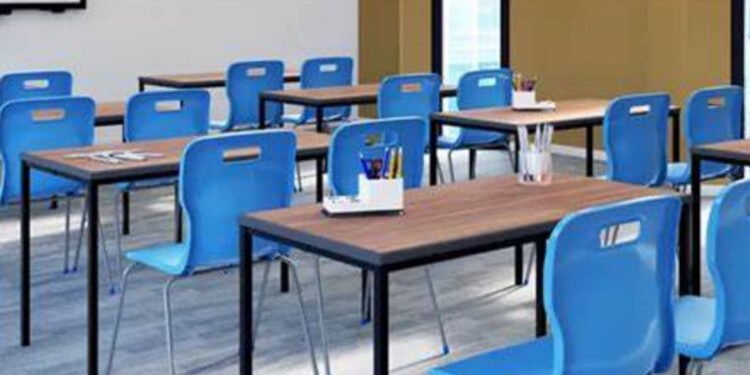Picking the right school chair for each grade level helps students stay comfortable and pay attention. Students spend hours sitting in classrooms, so having chairs that provide proper support can improve posture and concentration. The needs of younger children differ from those of older students, making it important to select chairs that match their developmental stages. A well-designed chair can help prevent discomfort and reduce distractions during lessons. Factors like size, durability, and flexibility should be considered when selecting chairs for different grade levels. With the right school chairs, students can have a more productive and comfortable learning experience.
Chairs for Early Childhood and Kindergarten
Young children need chairs that are small, lightweight, and easy to move. Since preschool and kindergarten students are still developing motor skills, their chairs should be designed with safety in mind. Rounded edges and sturdy materials help prevent accidents in the classroom. Many early childhood chairs are made from plastic, which is both durable and easy to clean. Stackable chairs work well in kindergarten classrooms because they’re easy to put away when unused. Comfort is also important, so chairs with a slight curve in the backrest can provide better support. Bright colors and fun designs can make the classroom environment more inviting for young learners. A properly sized chair ensures that children can sit with their feet flat on the floor, promoting good posture from an early age.
Chairs for Elementary School Students
Elementary school students need chairs that provide both comfort and stability. At this stage, children are more independent and spend more time sitting during lessons. Chairs with a strong metal frame and a plastic or wooden seat are commonly used in elementary classrooms. Adjustable-height chairs can accommodate growing students and provide long-term use. Proper back support is essential, so chairs with a contoured design help prevent slouching. Since younger students can be energetic, chairs with a slight rocking or flexing motion can help them stay engaged. Stackable or lightweight chairs make it easy to rearrange the classroom for different activities. A well-chosen chair helps students focus on their work without discomfort or distraction.
Chairs for Middle School Students
Middle school students require chairs that balance comfort, durability, and flexibility. At this age, students experience growth spurts, so having appropriately sized chairs is essential. Many schools choose ergonomic chairs with a supportive backrest to encourage good posture. Chairs made with strong materials like reinforced plastic or metal last longer and hold up to daily use. Some classrooms benefit from chairs with a slight tilt or rocking motion, which can help restless students stay engaged. Mobile chairs with wheels are useful for collaborative learning environments, making it easier for students to move around. Adjustable-height chairs allow for a better fit as students grow throughout the school year. A supportive and well-constructed chair can help students stay focused and comfortable during long periods of learning.
Chairs for High School Students
High school students spend long hours sitting in classrooms, so their chairs should provide proper support and durability. Many high schools use chairs with a metal frame and a molded plastic seat, offering both strength and comfort. Ergonomic designs with lumbar support help students maintain good posture during lectures and study sessions. Some classrooms require flexible seating options, such as chairs with wheels or swivel bases, to accommodate different learning activities. Stackable chairs work well in multipurpose rooms because they’re easy to move around and set up differently when needed. Since high school students vary in size, having different chair heights available can ensure a comfortable fit for everyone. Padded seats may be a good option for classrooms where students remain seated for extended periods. A well-designed chair can contribute to better concentration and overall student well-being.
Chairs for Special Learning Environments
Some students require chairs that meet specific learning needs, such as those in special education classrooms. Adjustable chairs provide better accessibility for students who need customized seating options. Soft seating options, such as cushioned chairs or bean bags, can help create a more comfortable learning space. Chairs with armrests or additional lumbar support can benefit students who need extra stability. Sensory-friendly chairs with smooth surfaces and minimal distractions help students who are sensitive to their environment. Some classrooms use alternative seating options, such as wobble stools, to support students who have difficulty sitting still. The right chair can make a significant difference in a student’s ability to focus and participate in class. A well-chosen chair can help create an inclusive learning space for all students.
Selecting the best school chairs for different grade levels plays a key role in creating a comfortable and effective learning environment. Younger children need small, lightweight chairs with safety features, while older students benefit from ergonomic designs that provide proper support. Adjustable and flexible seating options help accommodate students as they grow and develop. Durable materials ensure that chairs can withstand daily use in busy classrooms. Special learning environments require chairs that address specific student needs, providing additional support or sensory-friendly designs. The right school chairs contribute to student focus, posture, and overall classroom experience. Investing in quality seating helps create a more productive and engaging space for learners at every grade level. A well-chosen chair can positively impact a student’s daily comfort and academic success.












